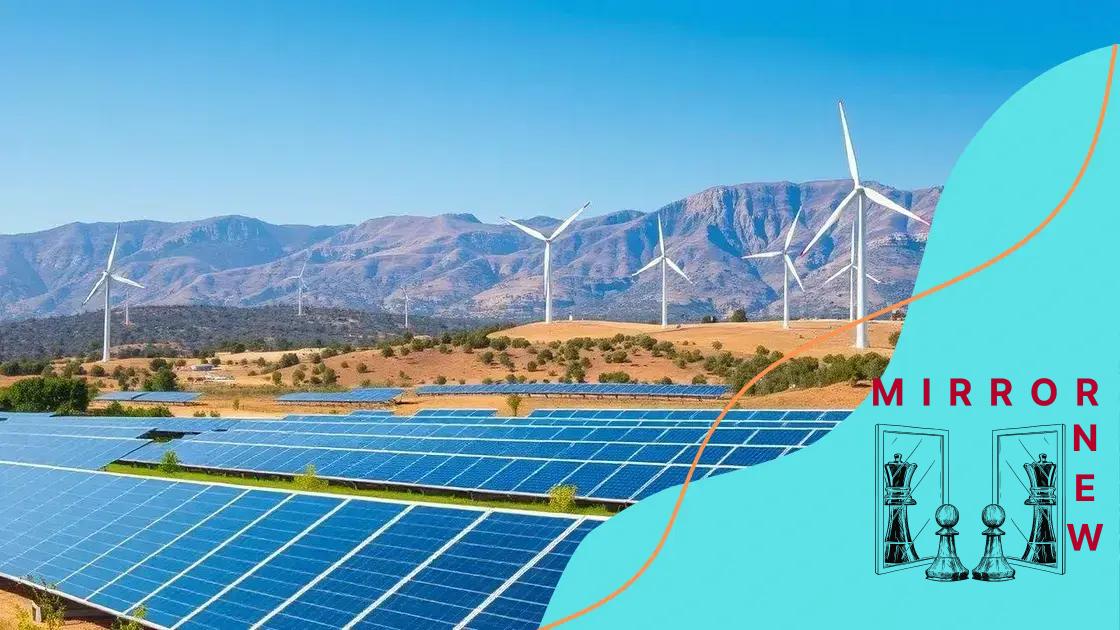Renewable energy incentives and subsidies: a guide

Renewable energy incentives and subsidies provide financial support to encourage the adoption of sustainable energy solutions, helping to reduce costs and promote a cleaner environment.
Renewable energy incentives and subsidies play a crucial role in promoting a cleaner energy future. These programs aim to encourage individuals and businesses to adopt sustainable energy practices. Are you curious about how these incentives can affect your choices?
Understanding renewable energy incentives
Understanding renewable energy incentives is crucial for anyone looking to invest in sustainable energy solutions. These incentives are designed to encourage the adoption of technologies that use renewable resources such as wind, solar, and hydroelectric power.
Types of Incentives
There are various types of incentives available, each with its unique benefits. Some of the most common include:
- Tax Credits: These allow individuals and businesses to reduce their tax liabilities when investing in renewable energy systems.
- Grants: Financial assistance that does not need to be repaid, used to help cover the costs of renewable energy projects.
- Rebates: Cash payments offered by governments or utility companies to encourage the installation of renewable energy technologies.
- Feed-in Tariffs: Agreements that guarantee a fixed payment for energy produced from renewable sources, encouraging more installations.
Understanding these options helps you make informed decisions when considering renewable energy investments. Furthermore, different regions may offer specific programs tailored to local energy goals. It is always best to research what is available in your area.
How Incentives Work
The structure of these incentives varies greatly. For instance, tax credits can significantly lower the upfront cost of systems like solar panels, making them more affordable for homeowners. Grants often target community projects, encouraging small-scale renewable systems that benefit local groups. When you apply for a renewable energy incentive, you typically need to demonstrate your project’s viability and adherence to guidelines set by the granting body.
Choosing the right incentive can maximize your investment. It’s wise to consult with energy experts or local energy offices to navigate available options. These professionals provide valuable guidance, enhancing your chances of securing financial support.
As communities shift towards greener alternatives, understanding renewable energy incentives becomes vital for participation in this important movement. With a variety of options available, individuals and businesses have the opportunity to contribute to a sustainable future while benefiting from financial savings.
Types of subsidies available
There are several types of subsidies available for renewable energy projects, each designed to support different aspects of energy sustainability. Understanding these options can greatly influence your decisions when pursuing renewable energy investments.
Direct Financial Support
One category of subsidies includes direct financial support to individuals and businesses adopting renewable technologies. These can come in the form of:
- Grants: Funds that do not need to be repaid, aimed at covering part or all of the initial costs of renewable energy systems.
- Low-Interest Loans: Financial assistance with favorable interest rates that encourage the installation of renewable energy sources.
- Performance-Based Incentives: Payments based on the amount of energy produced from renewable sources, ensuring users benefit as they generate energy.
These financial incentives can lower the barrier to entry, making renewable energy systems more affordable for consumers.
Tax Benefits
Tax-related subsidies are another common type. These incentives help reduce the overall tax burden associated with investing in renewable energy. Examples include:
- Tax Credits: Deductions that lower your taxable income based on your renewable energy installations.
- Property Tax Exemptions: Some regions offer exemptions to property taxes for properties that integrate renewable energy systems.
- Sales Tax Incentives: Reductions or exclusions on sales tax when purchasing renewable energy equipment.
These tax benefits not only make renewable investments more appealing but also encourage long-term sustainability by reducing annual costs.
In addition, various government programs have evolved to provide support specifically within certain industries or technologies, showcasing the commitment to expand renewable energy usage. As these different types of subsidies become more widely recognized, awareness continues to grow about their vital role in transitioning to a greener economy.
How to apply for incentives

Applying for renewable energy incentives can seem overwhelming, but it’s a straightforward process once you know the steps. Many programs offer assistance, making it easier for individuals and businesses to transition to sustainable energy solutions.
Step-by-Step Application Process
Generally, the application process includes several key steps:
- Research Available Incentives: Start by identifying which incentives you may qualify for based on your location and energy projects. Local government websites often provide comprehensive lists.
- Prepare Required Documentation: Gather necessary documents such as proof of ownership, energy audits, or project plans that show how your initiative meets program criteria.
- Complete the Application: Fill out the application forms accurately, ensuring all required information is provided. Mistakes can delay processing time.
- Submit the Application: Follow submission guidelines. Some programs may require online submission, while others need paper forms sent by mail.
After you submit your application, be prepared to wait for notification on approval status. This can take time depending on demand and processing capabilities. Keeping track of your application through any provided tracking tools or contacts can help you stay informed.
Tips for a Successful Application
To improve your chances of getting approved, consider these tips:
- Stay Organized: Keep a checklist of all documents and forms you need for submission.
- Follow Guidelines: Adhere strictly to program requirements, as each incentive may have its own rules.
- Ask for Help: Don’t hesitate to contact program representatives if you have questions during the application process. They can provide valuable guidance.
Many people find applying for incentives worthwhile despite any initial confusion. The potential savings and benefits from transitioning to renewable energy sources make it an important step toward sustainable living.
Impact on energy bills
The impact on energy bills from adopting renewable energy sources is significant and beneficial. Many homeowners and businesses notice a decline in their energy expenses after installing renewable energy systems like solar panels or wind turbines.
Immediate Savings
Many users see immediate savings on their energy bills due to lower electricity costs. When you generate your own energy, your reliance on the grid decreases, leading to a marked reduction in utility expenses. With the rising costs of traditional energy sources, this can lead to substantial financial benefits.
Long-term Financial Benefits
In the long run, investing in renewable energy can provide even greater savings. These systems often pay for themselves over time through saved energy costs. Homeowners can recoup initial installation costs through lower bills and available incentives, making renewable energy systems an attractive financial decision.
- Fixed Payments: Some renewable systems offer fixed payment plans, protecting consumers from fluctuating energy costs.
- Net Metering: Homeowners can sell excess energy back to the grid, creating an additional stream of income and further reducing energy bills.
- Increased Home Value: Homes equipped with renewable energy sources often have higher resale values, attracting environmentally conscious buyers.
It’s essential to understand that while initial costs can be high, the long-term savings often outweigh these expenses. The rise in renewable energy adoption reflects a shift in how people view and manage their energy consumption. The impact on bills also extends to contributing positively to the environment by reducing carbon footprints.
As household and business reliance on renewable energy grows, so too do the financial advantages, ensuring that sustainability goes hand in hand with economic sense.
Future trends in renewable energy support
Future trends in renewable energy support indicate a shift towards more innovative and effective solutions. As the demand for clean energy grows, so do the methods of incentivizing its use.
Increased Government Initiatives
Governments across the globe are expected to ramp up support for renewable energy initiatives. This includes expanded funding for energy projects and incentives for research and development. These steps aim to ensure more accessible and affordable renewable energy solutions for consumers.
Technological Advancements
Technological advancements will also play a key role in the future of renewable energy. Innovations in solar panel efficiency and energy storage capabilities will likely drive down costs and increase the effectiveness of renewable energy systems.
- Smart Grids: Future power systems will utilize smart grids to manage energy distribution more efficiently, accommodating increased renewable energy input.
- Battery Technology: Improvement in battery storage technologies will allow users to store excess energy for later use, making renewable systems more reliable.
- Distributed Energy Systems: More homes and businesses will implement decentralized energy generation, reducing reliance on traditional power grids.
As renewable energy becomes a larger part of the energy mix, consumer engagement will also evolve. More people will make environmentally conscious decisions, driven by lower costs and increased awareness. Engaging with community-based renewable projects will be common, fostering collaboration and local investment in clean energy solutions.
With these trends, the future of renewable energy support looks promising. As economies transition to cleaner sources of energy, ongoing education and awareness will be vital in encouraging widespread adoption.
FAQ – Frequently Asked Questions About Renewable Energy Incentives
What are renewable energy incentives?
Renewable energy incentives are financial benefits provided by governments to encourage the adoption of clean energy technologies, such as tax credits and grants.
How can renewable energy subsidies reduce my expenses?
By utilizing renewable energy sources, you can significantly lower your energy bills, as these systems often cost less to maintain and operate compared to traditional energy sources.
What types of subsidies are available for renewable energy projects?
Common subsidies include tax credits, cash rebates, grants, and low-interest loans aimed at making renewable energy installations more affordable.
What is the application process for these incentives?
The application process typically involves researching available incentives, preparing necessary documentation, completing forms, and submitting them to the appropriate government agency.





